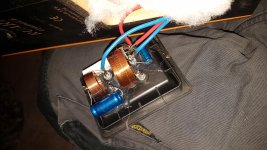Hello, first post and only started looking at building crossovers the last couple of days so please excuse any rookie mistakes.
I have a Ruark Dialogue One centre and Ruark Prologue Fronts with Ruark Icons rears.
I am really concentrating on the Dialogue centre at the moment to start with and if I don't mess it up completely will do the fronts.
Searching for info is difficult with the age of the speakers 1997 but a few bits I have found.
DESCRIPTION
Frequency Response: 62Hz - 22KHz +/- 3dB (free space conditions)
Nominal Impedance: 6 ohms
Amplifier Requirements: 25 - 120 watts
Sensitivity: 89dB/watt @ 1m
Dimensions HxWxD: 17.5cm x 48cm x 21cm
Weight each unpacked: 9Kg
Color finishes: Natural Cherry, Red Cherry, Natural Oak or Black Oak Veneers
Dialogue One
Design Type: Two way with one 28mm fabric dome tweeter, two 5" felted bass drivers, in an infinite baffle type enclosure.
Cabinet: 15mm MDF throughout.
Colour Finish: Oak Finish.
Crossover: Damped second order at 2.8Hz, five element with air cored inductors, both polypropylene and low loss electrolyic capacitors and high power resistors.
Frequency response: 70Hz -20KHz+/-3dB
Nominal impedance: 6 ohms.
Sensitivity: 90dB 2.83v.
Power handling: 150 Watts long term.
Dimensions H x W x D: 17cm x 48cm x 20cm
Weight each: 8Kg
There are also 2 versions which seems to mix up the searches, but I believe I have the original Dialogue One looking at pictures the tweeter was different in the 2nd revision.
So it is a 2nd order 2 way crossover at 2.8khz and it looks like it is similar to the Ruark Epilogue which I have had in bits and taken a picture of the crossover.
Originally I was thinking about replacing like for like with better components but then I thought if I am going to put the effort in to do that I might as well do more.
So using XSim I have put together a 1st order 3 way design because I think the fronts would really benefit from this, so I might as well do the centre the same way.
The original crossovers have a 10w 7.2ohm resistor so I believe this means it is around +6db over the drivers so worked around that with the new crossover.
So my plan is to take some measurements using the gated time window method or as close as I can get to it of the drivers and tweeter separately without the crossover in place and with the speakers in the cabinet so should then know exactly what -/+ I need to deal with and where the distortion starts/finishes for each as well as cabinet effect.
Then tweak the crossover design, I am thinking currently crossing over around 500hz and 4khz.
Does this sound sensible and am I missing anything blinding obvious.
Planning to use Clarity Caps, Mundorf Inductors and Resistors, cost should be around £90 per speaker.
Any opinions / help would be much appreciated.
Cheers
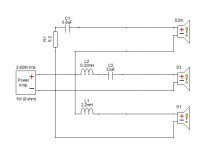

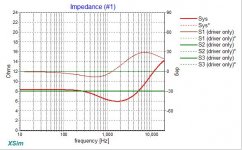
I have a Ruark Dialogue One centre and Ruark Prologue Fronts with Ruark Icons rears.
I am really concentrating on the Dialogue centre at the moment to start with and if I don't mess it up completely will do the fronts.
Searching for info is difficult with the age of the speakers 1997 but a few bits I have found.
DESCRIPTION
Frequency Response: 62Hz - 22KHz +/- 3dB (free space conditions)
Nominal Impedance: 6 ohms
Amplifier Requirements: 25 - 120 watts
Sensitivity: 89dB/watt @ 1m
Dimensions HxWxD: 17.5cm x 48cm x 21cm
Weight each unpacked: 9Kg
Color finishes: Natural Cherry, Red Cherry, Natural Oak or Black Oak Veneers
Dialogue One
Design Type: Two way with one 28mm fabric dome tweeter, two 5" felted bass drivers, in an infinite baffle type enclosure.
Cabinet: 15mm MDF throughout.
Colour Finish: Oak Finish.
Crossover: Damped second order at 2.8Hz, five element with air cored inductors, both polypropylene and low loss electrolyic capacitors and high power resistors.
Frequency response: 70Hz -20KHz+/-3dB
Nominal impedance: 6 ohms.
Sensitivity: 90dB 2.83v.
Power handling: 150 Watts long term.
Dimensions H x W x D: 17cm x 48cm x 20cm
Weight each: 8Kg
There are also 2 versions which seems to mix up the searches, but I believe I have the original Dialogue One looking at pictures the tweeter was different in the 2nd revision.
So it is a 2nd order 2 way crossover at 2.8khz and it looks like it is similar to the Ruark Epilogue which I have had in bits and taken a picture of the crossover.
Originally I was thinking about replacing like for like with better components but then I thought if I am going to put the effort in to do that I might as well do more.
So using XSim I have put together a 1st order 3 way design because I think the fronts would really benefit from this, so I might as well do the centre the same way.
The original crossovers have a 10w 7.2ohm resistor so I believe this means it is around +6db over the drivers so worked around that with the new crossover.
So my plan is to take some measurements using the gated time window method or as close as I can get to it of the drivers and tweeter separately without the crossover in place and with the speakers in the cabinet so should then know exactly what -/+ I need to deal with and where the distortion starts/finishes for each as well as cabinet effect.
Then tweak the crossover design, I am thinking currently crossing over around 500hz and 4khz.
Does this sound sensible and am I missing anything blinding obvious.
Planning to use Clarity Caps, Mundorf Inductors and Resistors, cost should be around £90 per speaker.
Any opinions / help would be much appreciated.
Cheers



Last edited:
Does this sound sensible and am I missing anything blinding obvious.
Planning to use Clarity Caps, Mundorf Inductors and Resistors, cost should be around £90 per speaker.
Any opinions / help would be much appreciated.
I suspect people are a bit baffled by your objectives.
You have a set of old working(?) budget speakers and are proposing to spend £90 per speaker in an effort to match current performance? I can see why you might want to do this if they were not working or some components had degraded to the extent of going out of spec but this is not the case? Or is it more that you expect a few expensive components in the crossover to significantly transform and improve the sound?
A 3 way crossover for a 2 way speaker makes no sense. First order crossovers are difficult to design, require many compensating components, require drivers with a wide passband, are almost always 3 or 4 ways because of the demands on the driver passbands, etc...
Not seeking to be overly negative but what you seem to want to do looks a bit odd given conventional objectives like cost effective improvements to sound quality. Alternative objectives like having a bit of time and money, wishing to gain some practical experience and it not mattering much if the speakers are degraded might make a bit make more sense but is this the case?
Thanks for the reply Andy, I thought there must be much more too this then just sticking a theoretical xover together in XSim.
The Ruarks where not exactly cheap back in the day, I think the fronts where around the £1,200 mark and the Icons where a little more but obviously budgets for everyone is different.
When you say 2 way, is it still 2 way if the two drivers are the same size and then obviously a tweeter.
They use 2 x Vifa OEM drivers made for Ruark which differ slightly so specs are hard to get.
Looks like there still xover at 2khz which is good.
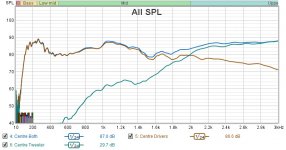
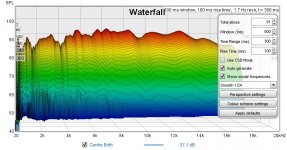
My idea behind doing 3 way was thinking it would separate the ranges up so the drivers wouldn't be trying to play 80hz and 2khz at the same time.
Speakers are working absolutely fine and after quickly grabbing some REW tests it looks like components haven't degraded / aged badly.
Objective wise, I guess it is a bit of "like to fiddle" kicking in... but I do kind of have a goal which I don't know if this will solve which is my ears.
I have a tendency to hear what I can only describe as a lisp or a harsh type sound, this isn't only with my speakers it is virtually all speakers on different amps, different houses etc.
My thought was if I lifted the tweeter well out of the way 4khz ish this might be better for me.
The Ruarks where not exactly cheap back in the day, I think the fronts where around the £1,200 mark and the Icons where a little more but obviously budgets for everyone is different.
When you say 2 way, is it still 2 way if the two drivers are the same size and then obviously a tweeter.
They use 2 x Vifa OEM drivers made for Ruark which differ slightly so specs are hard to get.
Looks like there still xover at 2khz which is good.


My idea behind doing 3 way was thinking it would separate the ranges up so the drivers wouldn't be trying to play 80hz and 2khz at the same time.
Speakers are working absolutely fine and after quickly grabbing some REW tests it looks like components haven't degraded / aged badly.
Objective wise, I guess it is a bit of "like to fiddle" kicking in... but I do kind of have a goal which I don't know if this will solve which is my ears.
I have a tendency to hear what I can only describe as a lisp or a harsh type sound, this isn't only with my speakers it is virtually all speakers on different amps, different houses etc.
My thought was if I lifted the tweeter well out of the way 4khz ish this might be better for me.
When you say 2 way, is it still 2 way if the two drivers are the same size and then obviously a tweeter.
Yes.
You will need both drivers playing at low frequencies to get the cone area. In the midrange there is the option to use just one midwoofer and to low pass filter the other. This is usually called a 2.5 way not a 3 way. It will require a more complicated crossover but would almost certainly work better with drivers chosen to work in this configuration. It is very unlikely to be a beneficial change using the current drivers in their current locations.
They use 2 x Vifa OEM drivers made for Ruark which differ slightly so specs are hard to get.
This is normal. Once a speaker manufacturer orders enough drivers for a full batch run it will have a negligible influence on price to get exactly what is wanted rather than the closest off-the-shelf driver.
Objective wise, I guess it is a bit of "like to fiddle" kicking in... but I do kind of have a goal which I don't know if this will solve which is my ears.
I have a tendency to hear what I can only describe as a lisp or a harsh type sound, this isn't only with my speakers it is virtually all speakers on different amps, different houses etc.
My thought was if I lifted the tweeter well out of the way 4khz ish this might be better for me.
From 2-4 kHz the tweeter will be moving pistonically and radiating sound widely. The midwoofers will be increasingly resonant with frequency and radiating sound in a narrowing beam with frequency. This is why the current crossover frequency is where it is. Raising it will make a noticeable change but the chances of it being for the better are remote.
Experimenting with crossover frequencies, slopes, adding dip or bumps to the response is time consuming and expensive with passive components. It is fast and zero cost with an active crossover if this is a viable option.
You will need both drivers playing at low frequencies to get the cone area. In the midrange there is the option to use just one midwoofer and to low pass filter the other. This is usually called a 2.5 way not a 3 way. It will require a more complicated crossover but would almost certainly work better with drivers chosen to work in this configuration. It is very unlikely to be a beneficial change using the current drivers in their current locations.
Thanks for clarifying, this makes perfect sense.
From 2-4 kHz the tweeter will be moving pistonically and radiating sound widely. The midwoofers will be increasingly resonant with frequency and radiating sound in a narrowing beam with frequency. This is why the current crossover frequency is where it is. Raising it will make a noticeable change but the chances of it being for the better are remote.
Experimenting with crossover frequencies, slopes, adding dip or bumps to the response is time consuming and expensive with passive components. It is fast and zero cost with an active crossover if this is a viable option.
So something like an L-Pad setup ?
So interestingly I took a measurement on the now replaced Epilogue and it has a completely different graph.
It looks like the xover is more around 4k with a tiny slope dropping to 10.5khz.
Maybe I should leave my better speakers alone and use the Epilogue to play with and see what kind of improvements I can make to them to satisfy my curiosity.
